How to Reset a Power Outlet Without a Reset Button in No Time?
Have you ever asked yourself how to reset a power outlet without a reset button? It might surprise you after discovering that there is no power or GFCI outlet reset button. This situation can confuse you if you are not aware of how to go about it.
The reason is that some power outlets do not come with either the reset button, a socket, or a receptacle. The good thing with these power outlets is that the circuit sometimes shares the reset button. Therefore, it’s upon you to locate the primary outlets connected to the button.
For now, let me take you through the process required when resetting a power outlet without a reset button, the reason behind it, and when to use the power outlet.
Table of Contents
Why Do I Have an Outlet Without a Reset Button?
Are you confused about why you have an outlet without a reset button? No more worries. I will give you several reasons why your power outlet has no reset button:
- Certain outlets are derived from or connected to others with a reset button. This implies that if you have numerous outdoor outlets connected to identical electrical circuits, all outlets will have one reset button.
- If your electrician has included additional outlets to a circuit containing a reset button, the new outlet will not have a reset switch.
- Lastly, a power outlet with no reset switch means a main GFCI outlet controls the rest of the circuits and will have a reset button.
Understanding When To Use Power Outlets
It is important to understand what types of outlets exist, under what circumstances it is permissible to use the outlet, and when to reset it. This will help to avoid any damage to the electrical devices or tripped circuit breaker and destroying other outlets. Let’s look a deeper look:
1. Types of Power Outlets
First, you need to know the types of power outlets. Let us look at three main types of power outlets:
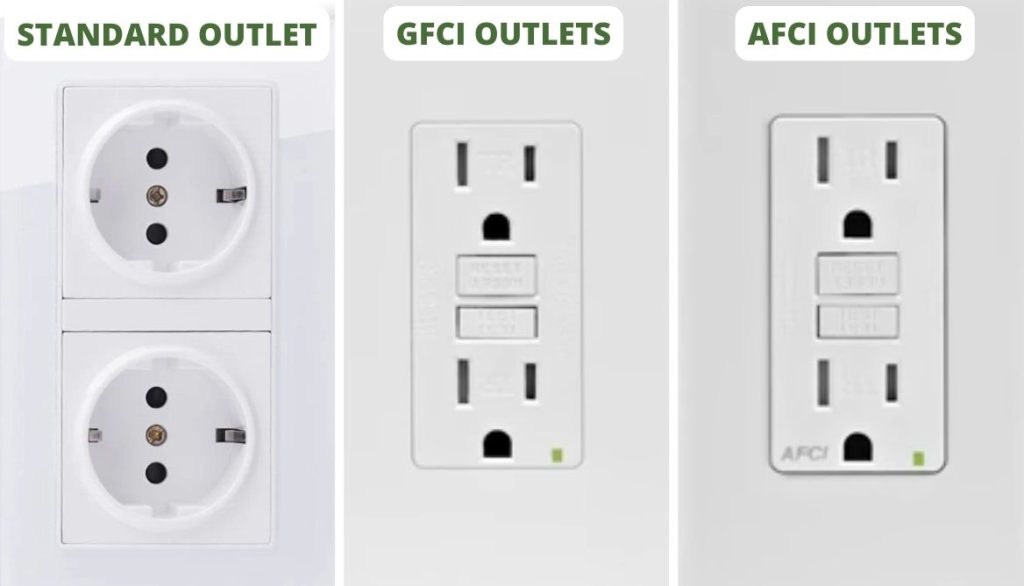
- Standard outlet: This type of outlet is mainly found in homes and its main purpose is to supply power to all electronic appliances.
- GFCI outlets: These are typically placed in locations where water is present to safeguard against electric shocks.
- AFCI outlets: The function of AFCI outlets is to identify arc faults and avert electrical fires.
2. Importance of Resetting Power Outlets
Next, it’s essential to know the importance of resetting power outlets. Here are some of the importance:
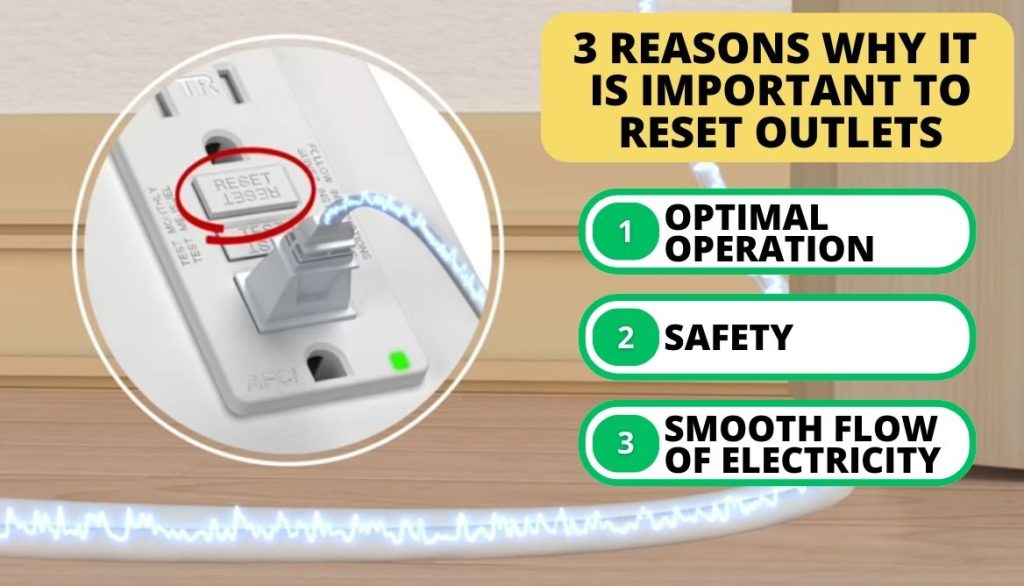
- Optimal operation: Rebooting power outlets is essential for upholding their optimal operation.
- Safety: It assists in solving problems such as electrical surges, tripped breakers, electrical fires, tripped circuit breakers, and any other temporary issues arising from electrical faults.
- Smooth electricity flow: Finally, resetting the power outlet can reinstate the electricity flow and guarantee an uninterrupted power supply to connected devices.
How to Reset a Power Outlet Without a Reset Button?
Don’t worry if you have a power outlet that lacks a reset button and need to reset it. Here are the steps you need to follow:
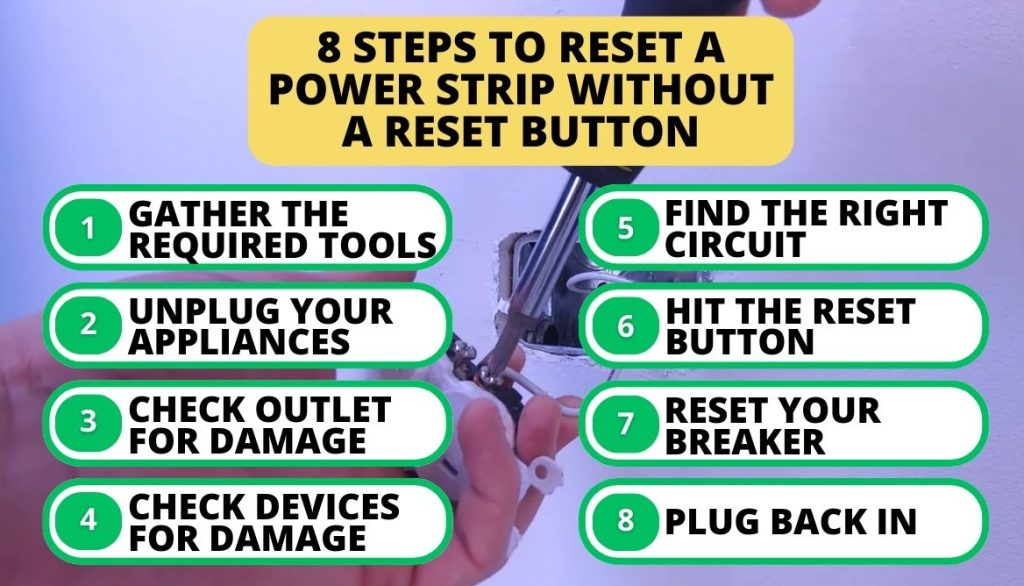
1. Tools Required
Sometimes, the power outlet may be out of function. This is simple, and you can easily do it by yourself. Here are some of the tools you will require for so doing:
- 4-in-1 screwdriver: This tool will assist in substituting the GFCI outlet, and tightening the connections.
- Flashlight: An alternative is to utilize rechargeable torchlights that remain plugged into the electrical socket and activate automatically during a power failure.
- Needle-nose pliers: Needle-nose pliers will be required to bend and shape the electrical wiring
- Safety glasses: Make sure that you wear safety glasses to prevent potential electric shocks and injuries.
- Voltage tester: You can use a Voltage tester to test and confirm if power is flowing through any outlets.

2. Unplug Your Appliances
When a GFCI or circuit breaker necessitates resetting, it signals potential issues such as:
- Circuit overloading;
- Problems with a light fixture or a device plugged into the outlet;
- Electrical faults within the system.
The initial step should involve disconnecting all devices and appliances from the impacted outlet as well as any other outlets linked to the same circuit.
Important! Even in cases where a power surge triggers the GFCI or breaker to trip, unplugging remains a prudent action to prevent damage to the appliances when you restore power.
3. Inspect the Outlet for Damage
At times, detecting the cause of the GFCI circuit breaker may be difficult; you need to inspect if the following signs are at the GFCI outlet:
- Signs of smoke;
- Sparking sounds;
- Popping;
- Visible damage.
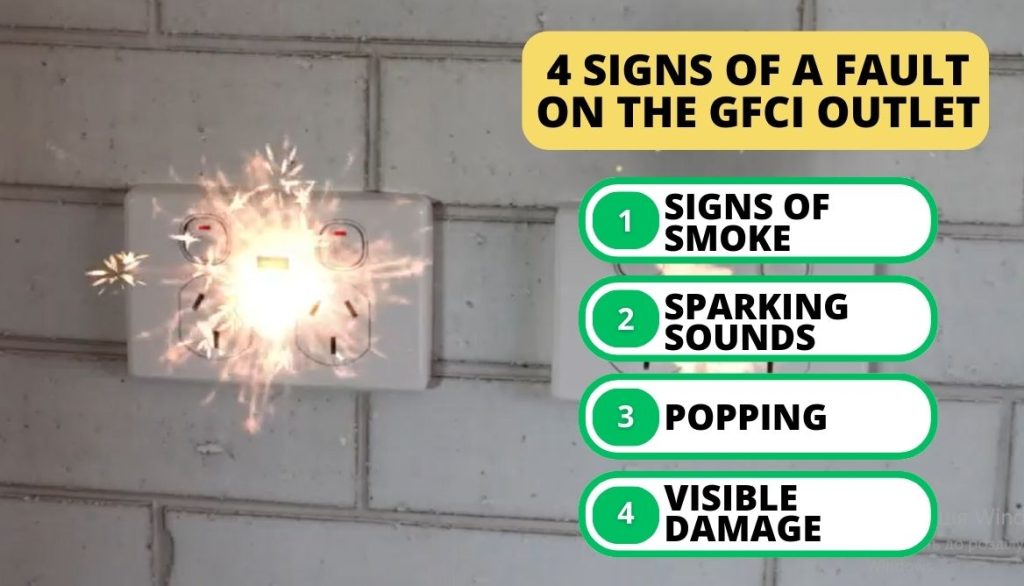
You should hurry up and switch off the power outlet after you have identified the damage. If you cannot fix the issue, you should not put on the switch again before you call an electrician. This should be done as soon as possible because damaged wires are common to electric shock.
4. Check Your Appliances for Damage
A malfunctioning appliance can lead to a situation where electricity is discharged through the structure of the device into the ground or even the GFCI protection box. This behavior is responsible for triggering a GFCI or circuit breaker trip.
To eliminate a potential appliance issue:
- Insert a functioning item into the troubled outlet and check if the GFCI or circuit breaker trips.
- If no problems occur when a different device is connected to the outlet in question, it’s likely that the appliance itself is the culprit behind the outlet problems.
5. Find the Right Circuit
If you are in need of the right circuit for the main GFCI outlet, the circuit breaker box at your door will provide you with information. You can also consider doing the following to identify the right circuit:
1. Inspect the surrounding outlets
If there is an inadequate or nonexistent map, examine neighboring outlets to the malfunctioning one. Check if the reset button on a nearby outlet needs to be pressed.
2. Use a lamp for the correct circuit
If you’re struggling to pinpoint the troubled circuit, employ a lamp with a switch to identify all circuit outlets.
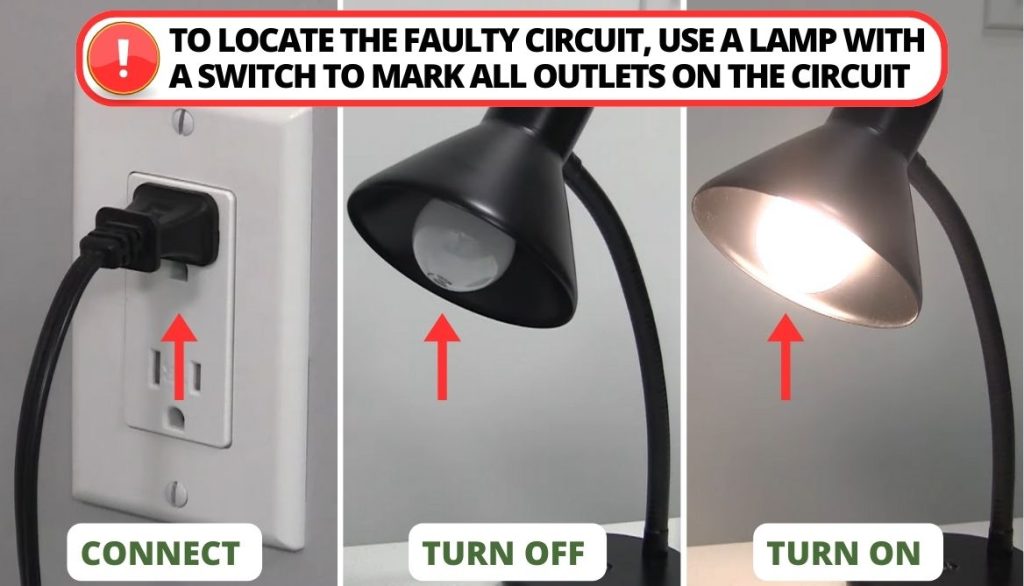
- Start by connecting the lamp to a known functional outlet to confirm its operation.
- Afterward, turn off the lamp, plug it into an outlet, and switch it on.
- Repeat this process until you identify a nonfunctional GFCI outlet, which is probably the one requiring a reset.
6. Hit the Reset Button
After identifying the circuit with the tripped GFCI and disconnecting all devices, you can press the reset button. A distinct clicking sound should confirm a successful reset, and the button should remain in the reset position with the black “test” button extended and the red “reset” button pushed in.
Important! If this measure doesn’t resolve the issue, you could be facing a more significant concern, so it is recommended to get in touch with a certified electrician to address the matter before reusing that outlet.
7. Reset Your Breaker
If the issues aren’t linked to GFCI-connected outlets, you may need to reset the circuit breaker. After disconnecting all devices from the circuit outlets:
- Go to the breaker box and search for any tripped breakers.
- Identifying a tripped breaker is straightforward: check for a switch not fully in the “on” position.
- Upon locating it, reset the breaker by toggling it from the “off” position to the “on” position.
- Once successfully reset, the switch should remain in the “on” position.
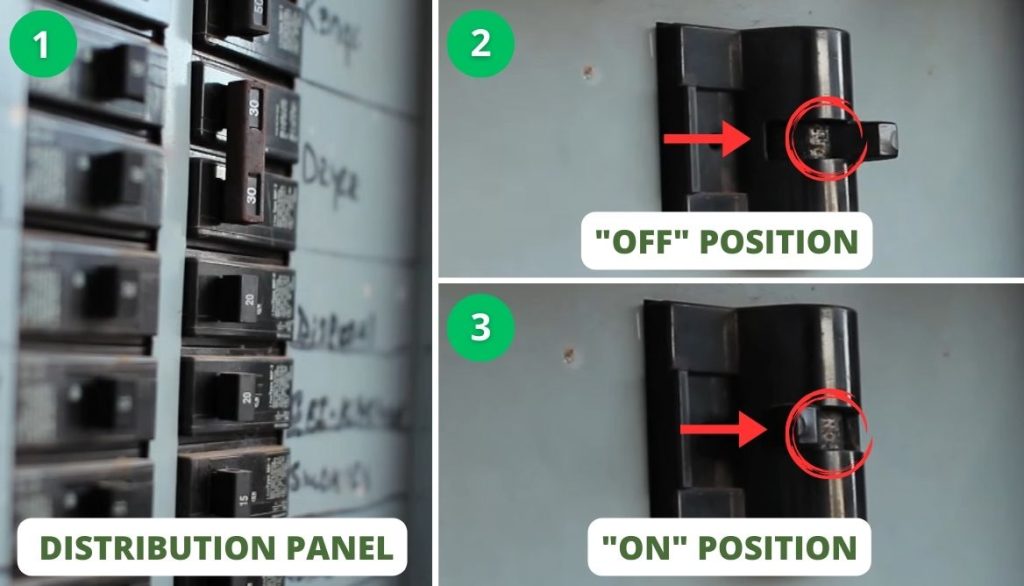
8. Plug Back In
After resetting the breaker and GFCI outlet, you can reconnect your appliances and switch them on. Your devices should function as usual immediately after you finish resetting a GFCI outlet. However, if they do not, you should verify that the electrical circuit is not overloaded and there is no damage to the outlet.
What To Do If The Power Outlet Reset Doesn’t Work?
If you press the reset button and still the power outlet doesn’t work, then there are some issues with your outlet. Here is what to do if it does not function at all.
1. Check the Breaker Box
If you test and reset a GFCI outlet, and it continues to trip, it’s a wise step to inspect the circuit breaker box to confirm that the circuit breaker hasn’t been triggered. Attempt to reset the outlet afterward.
Note: It is advisable in this case to call an expert to help in fixing the tripped breaker.
2. Dry the Power Outlet
After attempting to reset the outlet without success, excessive moisture accumulation within the wiring or the outlet itself could be the cause. Turn off the circuit breaker and use a hairdryer to remove the moisture from the outlet. Once it’s thoroughly dried, you can make another attempt to reset the button.
Note: Use the dryer with a lot of care. It produces a strong wave that can even melt the wires in the box.
3. Check if the Primary GFCI Outlet is Correctly Installed
A probable cause for the inability to reset your outlet is that the entire outlet might have been improperly connected. In the case of older homes, the GFCI may have been set up inaccurately. Fortunately, it is relatively straightforward to reconfigure and install the correct one. Here is what to do:
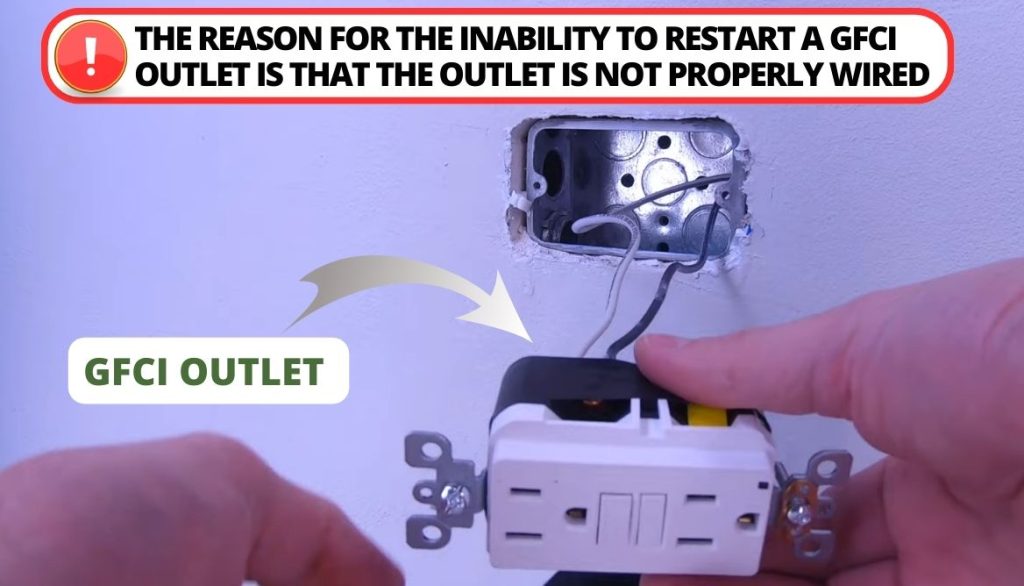
- Deactivate the electricity supply by switching off the circuit breaker or disconnecting the fuse.
- Confirm the absence of power using a voltage tester.
- Take out the current outlet from its position.
- Unhook the wires from the existing outlet. Strip away the insulation until 3/4-inch of the copper conductor is visible.
- Recognize the line wires and establish connections with the new wires.
- Insert the GFCI into the electrical wall box.
- Conceal it by attaching the wall plate.
4. Inspect if There is Any Ground Fault Wiring Issue
Occasionally, ground faults might be the underlying cause of your outlet’s inability to reset. If the GFCI consistently trips every time you attempt to reset it, there may be a ground fault along the branch circuit.
In such situations, it is advisable to contact a certified electrician for diagnostic work and necessary fixes. They can also examine your electrical panel, circuit breaker, electrical code compliance, and other outlets to confirm the absence of any further issues.
5. Ensure That There is a Power Supply to the Receptacle
When the receptacle lacks a power source, your GFCI outlets won’t receive any electricity. This implies that even if you press the reset button on the outlet, it will remain nonfunctional.
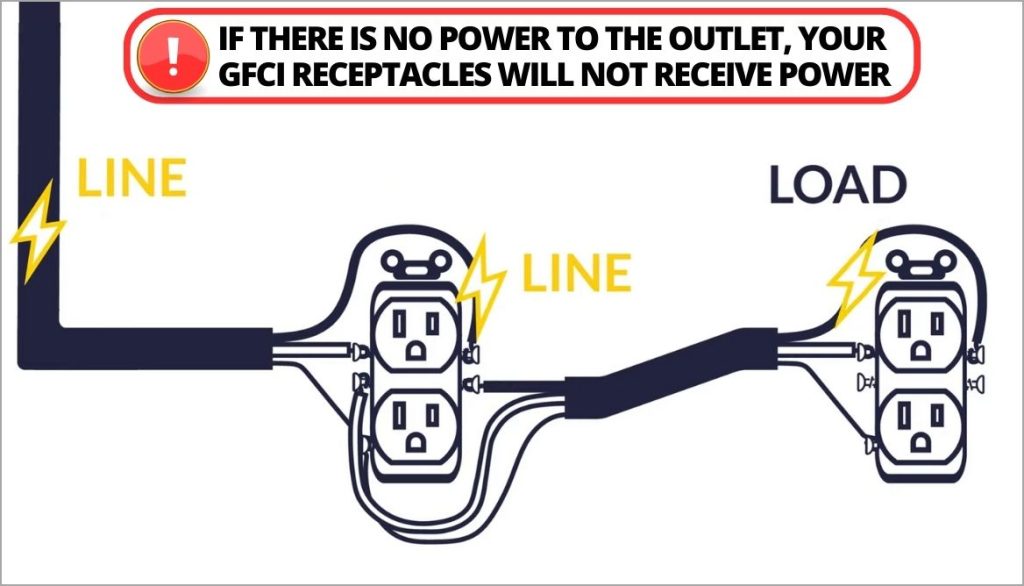
To address this, cycle the main circuit breaker’s power supply by switching it off and then on. If this approach doesn’t resolve the issue, you might consider enlisting the services of an electrician to diagnose and resolve the problem.
6. Consider Purchasing a New Outlet if the Existing One Is Past Ten Years
Every component has a finite lifespan, and this includes GFCI outlets. Typically, GFCI outlets have a longevity of approximately ten to fifteen years. If you’ve checked for other GFCIs that might have tripped and the outlet in question is older than a decade, it might be necessary to completely replace that specific GFCI outlet.
In such a situation, acquire a new outlet and arrange for a professional installation..
DIY vs Hiring a Pro
If you manage to locate the linked socket furnished with a reset button, and there are no additional complications regarding your socket, this becomes a self-help task with zero associated expenses.
Nevertheless, in cases of persistent issues or the discovery of other complications related to the socket or the wiring, it is advisable to engage the services of a nearby electrical expert.
- Substituting a problematic socket typically falls within the price range of $200 to $300.
- If you need to replace a malfunctioning circuit breaker, expect costs to vary from $100 to $260.
FAQs
Why Does My Outlet Keep Needing to Be Reset?
Numerous reasons can make your outlet in need of reset. These reasons include a GFCI outlet that keeps tripping, instances of ground-fault incidents, some water within the receptacle box, a circuit bearing excessive load, an electrical fault, and a defective GFCI outlet.
What Shouldn’t Be Plugged Into a GFCI Outlet?
Some of the appliances that are not supposed to be plugged into GFCI outlets are refrigerators/freezers and sump pumps simply because their wiring could be linked in a daisy chain fashion. This implies that multiple outlets may be connected.
Why Did My Outlet Suddenly Stop Working?
Your outlet will suddenly stop working if there are issues such as loosely secured wires at the terminal screw, impaired wire insulation, or burnt wiring. Furthermore, wires attached to the stab-in connection are known to become less secure over time, and those connected to the connectors can also experience loosening.
What Is the Lifespan of a GFCI Outlet?
GFCI outlets typically have a lifespan ranging from 10 to 15 years and should be replaced within this duration. Despite their extended operational life, it is advisable to periodically test them using the “Test” and “Reset” buttons.”
Where Can You Have a GFCI-Protected Outlet?
GFCI-protected outlets are mandatory in bathrooms, garages, crawl spaces, basements, laundry facilities, and locations where a water supply is accessible.
What Is the Difference Between GFCI Breaker and Circuit Breaker?
Ground-fault circuit interrupter (GFCI) serves as a method for safeguarding people against electric shocks. The GFCI will deactivate (interrupt) the circuit in the presence of current leakage. On the other hand, a circuit breaker controls the flow of electrical current within a particular room or zone in your residence.
What Are the Three Main Types of GFCI Outlets?
The three primary varieties of GFCI outlets comprise the Receptacle GFCI, which substitutes a regular duplex receptacle and fits into the standard outlet box. The GFCI Circuit Breaker is designed to safeguard an entire section of circuits, and the portable GFCI offers temporary protection to an outlet.
What Should I Do if I Can’t Find the Primary GFCI Outlet?
If you need help finding or recognizing the primary GFCI outlet, consult your residence’s electrical blueprint or reach out to an electrician for assistance.
Conclusion
Understanding how to reset a power outlet without a reset button, the categories of power outlets, and the significance of resetting them can contribute to the upkeep of a safe and efficient electrical setup.
If you need to reset the power outlet without a reset button, consider doing the following; unplug your appliances, inspect both appliances’ outlets for damage, find the right circuit, and hit the reset button. Remember, having only one GFCI outlet that serves as a primary outlet can make it easier to reset the outlet with no reset button.
Have you been experiencing difficulty resetting the power outlet without a reset button? Try using the above methods again and share your experience in the comment section.

I`m a current Law Enforcement Officer working within the Counterterrorism Bureau in New York State. I have been Camping for over 20 years. My styles of camping include tent, car, truck, van, and RV travel trailer. I have a YouTube channel where I teach all types of camping with an entertaining method: https://youtube.com/@TheSmallsRVAdventures





